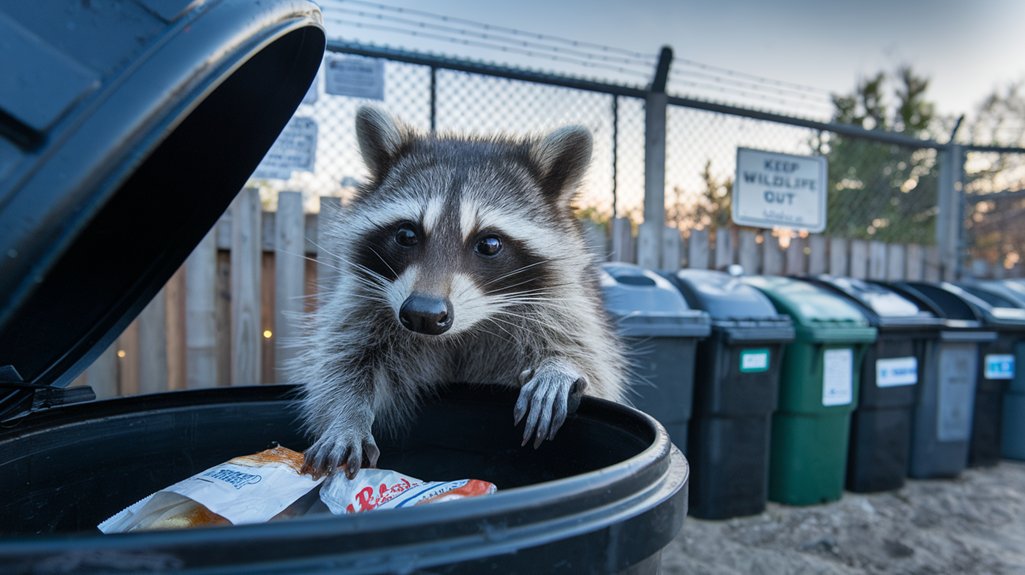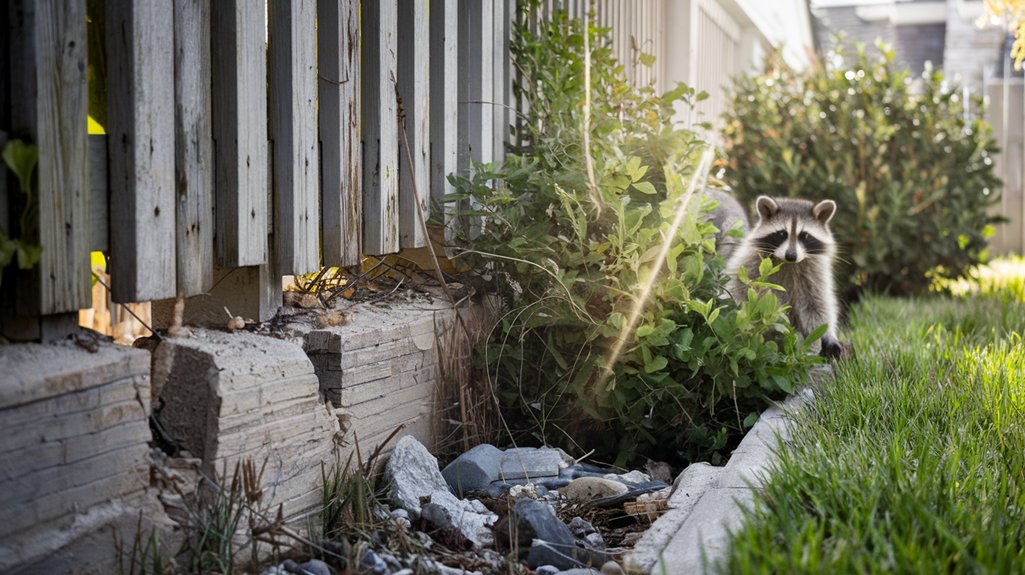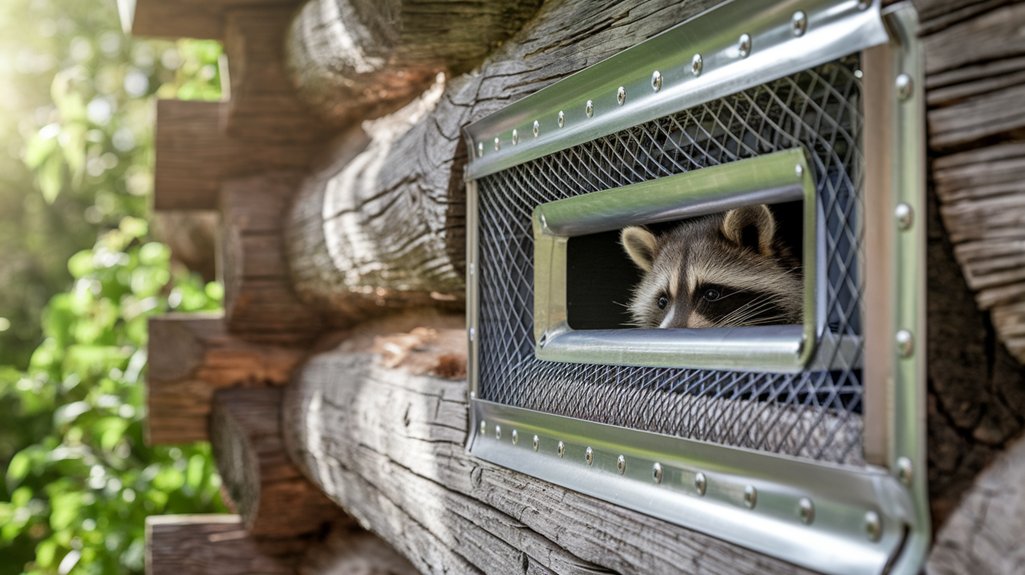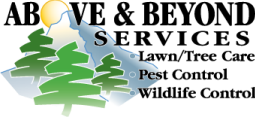When it comes to keeping animals out of your home or business, understanding the common wildlife intruders is just the beginning. You’ll need to assess your property for vulnerable areas and take proactive steps to seal entry points. By creating an unwelcoming environment and managing waste properly, you can significantly reduce the chances of unwanted visitors. But what specific strategies can you implement? Let’s explore the effective measures you can take to protect your space.
- Conduct regular property inspections to identify and seal gaps, cracks, and holes that could allow wildlife entry.
- Create an unwelcoming environment by clearing debris, trimming vegetation, and managing food sources like pet food and bird feeders.
- Utilize effective sealing methods such as weather stripping for doors, caulk for windows, and expanding foam for foundation cracks.
- Implement wildlife deterrents, including natural repellents, ultrasonic devices, and motion-activated lights to discourage animal intrusions.
- Establish physical barriers like fencing or netting to prevent wildlife access to your property.
Identifying Common Wildlife Intruders

When you venture outdoors or explore your property, you mightn’t realize how many common wildlife intruders could be lurking nearby.
Squirrels are often seen darting across trees or your roof, showcasing their acrobatic squirrel behavior. They can quickly chew through wires and insulation, making them a nuisance.
Raccoon habits, on the other hand, involve rummaging through trash cans or sneaking into attics. These nocturnal creatures are clever and can easily break into secured areas, seeking food or shelter.
Both species are resourceful and adapt quickly to their surroundings, so it’s crucial to be aware of their presence.
Recognizing their signs—like droppings or nests—can help you take action before they become a bigger problem.
Assessing Vulnerable Areas in Your Property

After identifying common wildlife intruders, it’s time to assess vulnerable areas on your property.
Start with a thorough vulnerability assessment. Walk around your home or business and look for gaps, cracks, or holes in your foundation, walls, and roof. Pay close attention to windows, doors, and vents, as these are often overlooked entry points.
Conduct regular property inspections, inspecting your landscaping for dense foliage or debris that could provide shelter for animals. Check for food sources like pet food or garbage that may attract them.
Identifying these vulnerable areas early can help you prevent potential wildlife intrusions, ensuring your space remains safe and secure. Awareness and proactive measures are key to effective wildlife prevention.
Sealing Entry Points Effectively

As you work to keep wildlife at bay, sealing entry points effectively is crucial to your success. Start by inspecting your property for gaps and cracks. Use caulk or expanding foam for sealing gaps in walls, and don’t forget to address your doors and windows. Weather stripping can be a game-changer, ensuring these openings are tight and secure.
Here’s a quick reference table to help you:
| Location | Method | Tips |
|---|---|---|
| Doors | Weather stripping | Choose durable materials |
| Windows | Caulk | Check regularly for wear |
| Vents | Screens | Ensure no tears or holes |
| Foundation | Expanding foam | Fill all visible cracks |
| Roof eaves | Repair shingles | Inspect annually |
Sealing these entry points will significantly reduce wildlife intrusion.
Creating an Unwelcoming Environment
To deter wildlife from making your property their home, creating an unwelcoming environment is essential.
Start by implementing natural barriers, like thorny bushes or dense hedges, around your property. These not only deter animals but also create a physical obstacle.
Next, consider habitat modification by keeping your yard tidy. Trim overgrown vegetation, remove any standing water, and clear debris where animals might find shelter.
If you have bird feeders, be mindful of their placement, as spilled seeds can attract unwanted visitors. Additionally, avoid leaving pet food outside, as it can lure in critters.
Proper Waste Management Practices
Creating an unwelcoming environment is a strong first step, but proper waste management practices are just as important in keeping wildlife at bay. Start by ensuring your garbage disposal is effective. Use tightly sealed bins and store them away from your home.
Regularly clean the area around your bins to avoid attracting animals with food residue.
Consider implementing composting techniques for organic waste, but be sure to use a secure compost bin that animals can’t access. This not only reduces food waste but also minimizes odors that might draw in unwanted guests.
Utilizing Wildlife Deterrents
While proper waste management lays the groundwork for keeping wildlife away, utilizing effective deterrents can further enhance your defenses.
By integrating various strategies, you can create an environment that discourages unwanted visitors. Here are four options to consider:
- Natural repellents: Use scents like peppermint or vinegar to repel animals from specific areas.
- Ultrasonic devices: These emit high-frequency sounds that are unpleasant for wildlife, keeping them at bay.
- Motion-activated lights: Sudden bursts of light can scare off nocturnal animals.
- Physical barriers: Fencing or netting can prevent animals from accessing your property.
When to Call a Professional Wildlife Control Service
When should you consider calling a professional wildlife control service?
If you notice wildlife signs like droppings, tracks, or nesting materials in or around your home, it’s time to take action. Ignoring these signs can lead to bigger issues, such as property damage or health risks.
Additionally, if you hear unusual noises in your attic or walls, don’t wait—call for an emergency response. Professionals have the expertise and tools to safely remove animals without harming them or your property.
You should also reach out if you can’t identify the animal or if it poses a danger, like a rabid raccoon. The sooner you act, the better you can protect your space from unwelcome wildlife.
Frequently Asked Questions
What Are the Best Natural Repellents for Wildlife?
When you’re looking for the best natural repellents for wildlife, consider using citrus oils and vinegar solutions. They’re effective at deterring unwanted animals and are safer alternatives compared to chemical options. Give them a try!
How Can I Tell if Animals Are in My Attic?
To tell if animals are in your attic, watch for signs of intrusion like droppings or chewed wires. You might also hear nocturnal noises, such as scratching or scurrying, indicating a potential visitor up there.
Are There Specific Plants That Deter Wildlife?
Absolutely, certain herb choices like mint and rosemary can deter wildlife. Incorporate them into your garden layout to create a natural barrier. Just remember to place them strategically for maximum effectiveness against unwanted visitors.
What Should I Do if I Find a Baby Animal?
If you find a baby animal, observe it first. If it seems abandoned, contact a wildlife rehabilitation center for guidance. You can help with baby animal rescue by following their wildlife rehabilitation tips and ensuring the animal’s safety.
Can Pets Help Keep Wildlife Away From My Property?
Yes, pets can help keep wildlife away. Their natural instincts and behaviors often deter animals from entering your property, as the presence of a dog or cat signals potential danger to other creatures.
In Closing
By taking proactive steps to prevent wildlife intrusions, you can protect your home and business from unwanted animal visitors. Regularly assess your property for vulnerabilities, seal entry points, and create an unwelcoming environment. Don’t forget to practice proper waste management and consider using deterrents. If you encounter persistent issues, don’t hesitate to call a professional wildlife control service. With these strategies, you’ll keep your space safe and secure from wildlife intruders.
